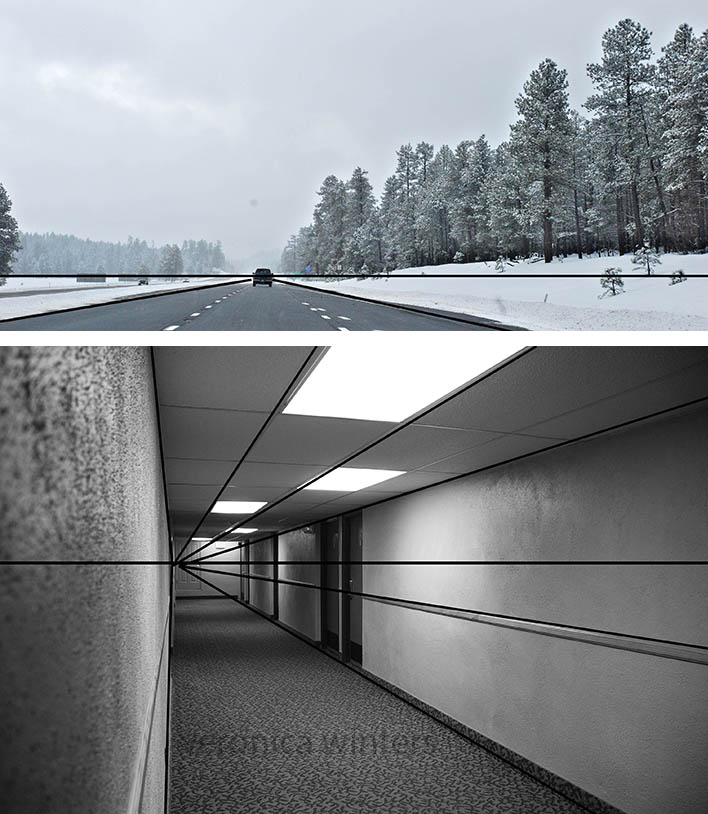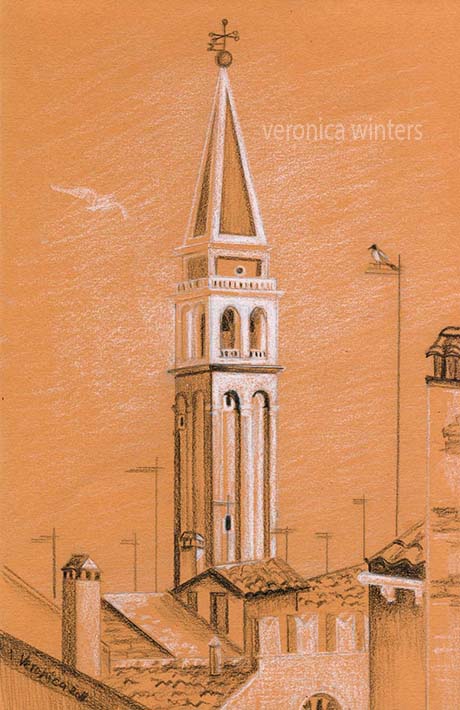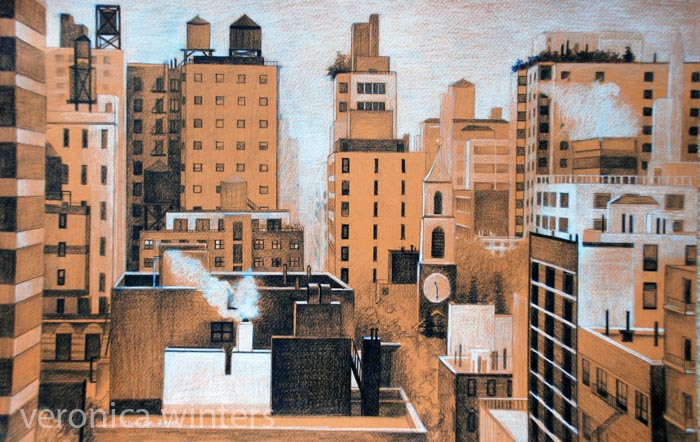There are two types of perspective: linear and aerial. Both types of perspective work simultaneously in artist’s paintings to give a complete illusion of dimension, space, and depth.
Learn about these two types of perspective in art.

Atmospheric perspective
Aerial or atmospheric perspective refers to colors and our sense of detail, looking at objects up close or far in the distance.
When an object is in the distance, its colors lose their intensity, becoming weaker and grayer. Objects also lose detail and sharpness in relative proportion to distance. This knowledge is essential for choosing and mixing colors and for working out the details and lost-and-found edges.
Based on this rule, draw the objects that are up close to you with maximum color intensity and sharpness, fade everything else behind it to create the distance and atmosphere.
One-point perspective
Drawings have a one-point perspective when a single vanishing point (VP) seats on the horizon line. The position of the vanishing point can vary in its horizontal location, but it always stays on the horizon line. Therefore, draw the horizon line first, then determine the VP position on it.
In the image below you see how the road lines converge in a single VP. The right position of converging lines helps you draw with accuracy the exact size of objects receding in space. For instance, the trees’ size on the right changes in accordance with the linear perspective.

We observe such perspective by looking at highway roads, railway tracks, hotel hallways, or even buildings that we see facing us directly. The image of a hallway above shows the position of one VP on a horizon line, and all lines converge in it far in the distance. This helps us draw the exact size and the slant of the hotel’s doors and lights.
Two-point perspective
Images have a two-point perspective when they have two vanishing points (VPs) present on the horizon line. Seen from the corner, one wall of a barn or a building would recede towards one vanishing point on the left, while the other wall recedes towards the opposite vanishing point on the right, like shown here.

In the picture, two vanishing points are often placed at varied, uneven distances on the horizon line. This explains a different slant of one side of the building in comparison to the other. The closer the VP, the sharper the roof’s and wall’s slant. (In this picture, the right side of the barn has a steeper slant, with converging lines going to a much closer vanishing point in comparison to the left side).
Because of the linear perspective, objects often appear foreshortened, and if you don’t draw them as such, you lose your sense of perspective. Here, horses in the distance become smaller and foreshortened.
Three-point perspective
A three-point perspective is used to describe the illusion of 3-D space in buildings seen from above (or below). In addition to the two vanishing points we’ve already discussed — one for each wall on the right and left — there is the third point to describe how the vertical lines of the walls recede in space.
If you look down at a building from above, for example, the third vanishing point is placed below the ground. If you stand on the ground and look up at a tall building, the third vanishing point is high in space.

In the image of a Venetian tower, I have a two-point perspective despite the street view (a street-view composition is usually a three- or even four-point perspective), simply because I look straight at the view from my window. That is, I was not looking up or down at the building.

In the colored pencil drawing of the New York’s upper east side skyline, below, I have a three-point perspective because I’m looking at the buildings being slightly above and looking down.

Some examples shown there are not very good. Regarding the one-point perspective: the second picture shown here is not one-point perspective: as you can see, parallel lines (for example, on the ceiling) perpendicular to the lines you've marked still do converge to one point on the right, albeit that point is farther. The true one-point perspective has — that is — one VP, with other one being ‘degenerate’ in the mathematical sense and being placed sort of at the ‘infinite distance’, making all lines converging to it appear actually parallel. About the three-point perspective: that picture you've shown is not very good: really, it looks like either there is no third VP at all or it is very, very far away (i. e. you're still looking down, but at a very small angle); I think you probably should've used something more illustrative (not gonna lie: every three-point perspective picture ever except for THIS one) for beginners.